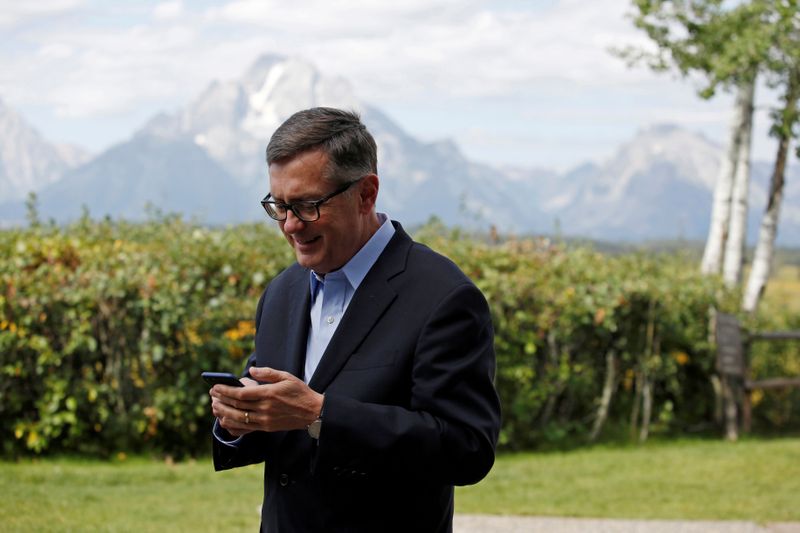Jobs, inflation data surprises not changing Fed plans, Clarida says
© Reuters. FILE PHOTO: Federal Reserve Vice Chair Richard Clarida reacts as he holds his phone during the three-day “Challenges for Monetary Policy” conference in Jackson Hole, Wyoming, U.S., August 23, 2019. REUTERS/Jonathan Crosby/File Photo By Howard Schneider and Ann Saphir
WASHINGTON (Reuters) – It will be “some time” before the U.S. economy is healed enough for the Federal Reserve to consider pulling back its crisis-levels of support, Fed Vice Chair Richard Clarida said on Wednesday, adding that the twin surprises of weak jobs growth and stronger inflation in April hadn’t dented the U.S. central bank’s plans.
The U.S. Labor Department on Wednesday reported that the consumer price index rose 4.2% in the 12 months through April. That was the largest gain since September 2008 and a number that Clarida said was “well above” what he expected.
It’s the second time in a week Fed policymakers have had their expectations foiled on a major piece of economic data: the economy added just 266,000 jobs in April, about one quarter the gain expected by Fed officials and many economists.
In remarks to a National Association of Business Economics symposium, Clarida called it the “biggest miss in history.”
He said, however, that he still anticipates the rise in prices will prove temporary, while the weak employment report makes the pace of the jobs recovery “more uncertain” and proves the Fed’s “wisdom” in promising to keep monetary policy loose.
“We would not hesitate to act to bring inflation down,” Clarida said. But “this is one data point, as was the labor report … We have been saying for some time that reopening the economy would put some upward pressure on prices.”
The collision of higher inflation and weaker job growth has echoes of the damaging “stagflation” of the 1970s, and would be the worst of both worlds for a central bank charged with maintaining both high levels of employment and stable prices.
It is also stoking debate over whether ongoing pandemic aid programs are out of step with the economy’s current conditions. That issue has prompted several Republican governors to say they will stop an enhanced federal unemployment benefit because they feel it is encouraging people not to work; members of the Biden administration say fears of the pandemic and practical issues like child care are the factors keeping people from taking jobs.
Both the White House and the Fed are keeping close watch on the details. For the central bank, the fact that market and household expectations about future inflation have so far moved to its 2% target – as hoped – but not far above it gives it confidence an upcoming few months of price hikes will not continue. (Graphic: Fed inflation expectations index, https://graphics.reuters.com/USA-FED/EXPECTATIONS/xklvywnxyvg/chart.png)
Still, market and economic analysts have begun to question whether the Fed is at risk of falling behind an inflation cycle that may be developing precisely because workers are reluctant to return to jobs even as a demand surge and supply bottlenecks push prices higher.
The question is how quickly all that resolves in the midst of what Clarida said was a “rebalancing” of U.S. labor markets that may involve structural mismatches between the jobs being demanded by companies and what workers are willing to do as a post-pandemic “normal” emerges.
Based on inflation alone, “the Fed might be planning its first rate hike around now but apparently this won’t happen for some time,” said John Leiper, chief investment officer at Tavistock Wealth. “(Fed Chair Jerome) Powell is running the Fed like he’s a football manager going into extra time … But he hasn’t heard the final whistle.”
Stocks on Wall Street fell and bond yields rose after the data on Wednesday. Interest rate futures traders renewed bets the Fed could start raising rates by the end of 2022.
The breakeven rate on 10-year Treasury Inflation-Protected Securities (TIPS) rose to 2.58%, the highest level since early 2013. (Graphic: U.S. inflation gauges, https://graphics.reuters.com/USA-STOCKS/yzdvxzqdrvx/inflation.png)
‘NECESSARY REBALANCING’
Frances Donald, global chief economist with Manulife Investment Management in Toronto, said it won’t be until this summer until there is a clear signal on whether higher inflation will persist.
“This inflationary pressure in April is not driven by broad-based inflationary pressure,” Donald said, but rather by comparison to the weak prices seen at the start of the pandemic last spring.
The Fed certainly expects it to abate, allowing it to maintain policies it hopes encourages higher levels of employment.
At the recent current pace of job growth, Clarida noted, it would be August of 2022 before the United States returns to its pre-pandemic level of jobs, even as the level of overall output likely gets back to that level this year. (Graphic: Jobs lagging GDP, https://graphics.reuters.com/USA-FED/JOBGROWTH/rlgpdyjlevo/chart.png)
In the meantime, “we are committed to using our full range of tools to support the economy for as long as it takes until the job is well and truly done,” Clarida said of reaching maximum employment, adding it would be “some time” before employment is recovered fully enough for the Fed to consider paring back its $120 billion in monthly bond purchases.
The Fed has said any move to raise its near-zero benchmark overnight interest rate would come even later.
While the recovery of overall output is expected to “pick up steam” this year, Clarida said, “the near-term outlook for the labor market appears to be more uncertain.”
“What this necessary rebalancing of labor supply and demand means for wage and price dynamics will depend importantly on the pace of recovery in labor force participation as well as the extent to which there are post-pandemic mismatches between labor demand and supply in specific sectors of the economy and how long any such imbalances persist,” Clarida said.












 Bitcoin
Bitcoin  Ethereum
Ethereum  Tether
Tether  XRP
XRP  USDC
USDC  Solana
Solana  TRON
TRON  Lido Staked Ether
Lido Staked Ether  Dogecoin
Dogecoin